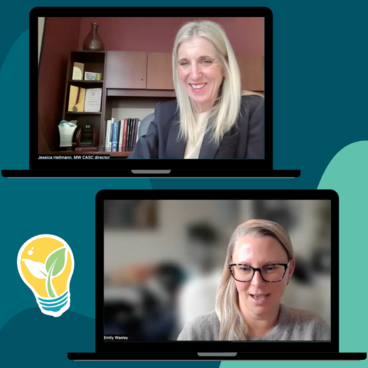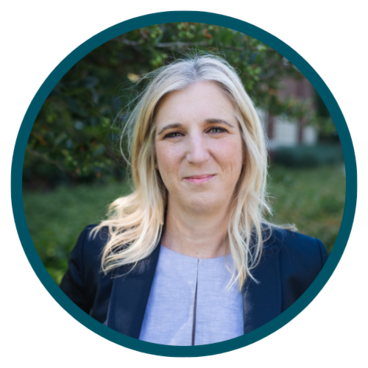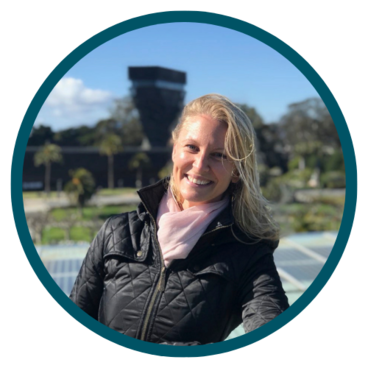
On March 7, 2024, the Midwest Climate Adaptation Science Center (MW CASC) hosted Emily Wasley, lead author of the Adaptation Chapter of the 5th National Climate Assessment, as our inaugural Innovation in Adaptation speaker.
Emily, currently head of climate resilience and biodiversity for Meta, is a thought leader in the field of climate adaptation with almost two decades of experience. She joined Jessica Hellmann, MW CASC consortium director and executive director of the University of Minnesota’s Institute on the Environment, in a thought-provoking conversation about the Fifth National Climate Assessment, centering equity in adaptation, and the need to move from incremental to transformative adaptation.
Video Recording
Conversation Highlights

Jessica Hellmann: There's been a lot of evolution in the field of adaptation throughout your career. What is your understanding of adaptation as a discipline right now, its strengths or its weaknesses?
Emily Wasley: I see adaptation as very local. It has to take place with the communities and with the organizations that provide a voice for the ecosystems that we depend on. There are so many new opportunities out there, but there is differential access to funding and investments. For example, some communities may not have the capacity to write a grant to get funding for an adaptation solution that they want to put into place before an event happens.
There's also the challenge of some communities taking incremental adaptation actions because that's what they can afford, or that's what they understand. Incremental here means short term – Band-Aid fixes that will address maybe one climate-related hazard, like extreme heat. For example, incremental adaptation might be making sure that communities have access to air conditioning, compared to transformational adaptation, which is more related to how we're designing buildings to withstand these climate hazards for the long term.

Jessica Hellmann: You said that adaptation is fundamentally a local phenomena, and yet we write a National Climate Assessment and talk about global adaptation targets through the U.N. Conference of the Parties. How do you rectify that – thinking about something globally or nationally or across an entire company like Meta – with a process that’s fundamentally local?
Emily Wasley: It is a massive challenge – I don't think anyone has quite figured it out yet. But what we tried to do throughout our National Climate Assessment chapter was to weave in very sectoral-based solutions and regional solutions related to adaptation. We highlighted the actions that are taking place on the ground and wove that into our first key message, which is that adaptation is occurring, but it's insufficient.
We also don't have a sustainable, systematic way to monitor and evaluate the effectiveness of adaptation actions, the sufficiency of those actions, whether they're leading to maladaptation or to success, and what success looks like. Another one of our key findings is that more monitoring and evaluation needs to happen at the local level to really understand what solutions are working and why. And how can we share those solutions across the board so that other communities can understand what works and what doesn't, so that they're not wasting resources on solutions that may not be effective in the long term.
Jessica Hellmann: One barrier to transformational adaptation is this "return to baseline" expectation, the idea that we'll build back what was rather than what could be. What are some other barriers that you see to the notion of transformational adaptation, as you define it?
Emily Wasley: I think inherently humans are not comfortable with change and transformational adaptation takes change. Humans have the inclination to preserve the current state, even if changes might bring greater benefits. Preserving the status quo, for example, can actually perpetuate existing systems of inequality. We have to understand as a human species that nature will survive without us, but if we want to survive, adapt, and thrive in a changing climate, transformational change is required.
Another barrier is a lack of understanding of what adaptation is and what it's not. A lot of people confuse adaptation with disaster response and recovery, and that's a pretty dangerous spot to be in. Adaptation is thinking about proactive, long-term systemic changes, whereas emergency response and disaster recovery is a reaction after an event happens.
We also need a shared understanding that just because we need to invest in adaptation doesn't mean we're taking money away from mitigation. That has been an intense debate for a long time. Adaptation and investing in climate resilience will help us in the long run. It will be expensive, but it's totally worth it – it's been found that if you invest $1 in adaptation, you get $15 back in return.
Jessica Hellmann: How do you see the relationship between climate justice and adaptation?
Emily Wasley: That's an area that we really dove into in the Adaptation Chapter and throughout the entire National Climate Assessment. Equity and justice are woven throughout because it's so interconnected.
If you're intentional about adaptation and the way that you're planning, and you plan inclusively with communities, then hopefully it will be successful. But a lot of times, those decisions are being made without voices from the communities that will be impacted the most, so you get these actions or these solutions that are not equitable. They may even exacerbate the impact and harm the communities that you're trying to help. In order to be transparent and collaborative, we have to include those voices from the start and throughout. We can't just come up with a plan and then ask them to review it – that's not going to work.
Jessica Hellmann: When you were describing your career arc, you talked about being in public service, federal government, and now in the private sector. What do you see as the specific role or responsibility for the private sector in advancing adaptation? For those of us coming from a natural resource sector background, is there any opportunity for us to work together?
Emily Wasley: I think there are a lot of different opportunities. Some are in relation to different innovations that we might be investing in to scale up, because the private sector does have a lot of resources and a lot of funding. We can pilot different solutions at our locations and with the surrounding communities to see if things work and if they could be long term solutions. One of the actions that we're trying to take now, in alignment with our net zero goal, is to reduce our diesel generators, which provide backup power for our data centers. There's a trade off between doing that and making sure that our data centers are protected and resilient in the face of extreme weather events, so we're looking at different alternative energy sources to power those backup generators.
Also, in terms of engaging with communities, I think there's a lot that we can do related to sharing information and results from risk assessments that we've done. I just completed a very in-depth engineering study across all of our different data centers at the building level. We looked at not just the downtime potential for our data centers, but also impacts to the power grid, water utilities, and the fiber network so that we understood all of the potential vulnerabilities. We can share that with communities that may not have the resources to do this type of analysis – I think that's a huge opportunity for us to be a good steward in these communities.
On the natural resources side, I also manage the biodiversity program. I incorporate biodiversity into climate resilience, because it's a risk management measure. It's a measure to enhance resilience. We are protecting more land than we develop on and there are different ways that we work with NGOs and academia to understand how we're measuring biodiversity, how we can enhance our biodiversity efforts and really build that into thinking about how climate change will impact natural resources over time.
Jessica Hellmann: We’ve gotten some questions related to professional opportunities in this sector. What do you think about the trajectory of opportunities related to adaptation or sustainability generally? What are the roles and capacities that they have? Do you see growth in this adaptation sector within employment in the private sector?
Emily Wasley: The sustainability space is super crowded because there are a lot of folks that have been doing this for a long time and studied it in graduate school. On the climate adaptation side, there aren't as many schools that are investing curriculum in climate adaptation or climate risk assessments. There is an understanding that having some experience in that space for adaptation is helpful because you might learn some theories or concepts about adaptation, but having practical experience is really, really helpful. Even if it's just at the ground level, interning for an organization during the summertime – just make sure you get paid what you’re worth, because the adaptation space is very undervalued in terms of pay.
This is a growing area because we're seeing more extreme weather events, we're seeing companies more engaged in this topic. In the future, I think we’ll see many more open positions for teams to grow in this space. As it stands right now within Meta, I'm on the net zero team and I'm one person that manages climate, risk, and biodiversity across the company, so there’s still a lack of capacity within companies. But I see that growing just like it did in the sustainability space – just be patient and dig into what brings you joy.
As for skill sets, it’s important to understand scenario analysis, how to conduct a climate risk assessment, and how to understand the difference between inherent risk and residual risk. If you have an engineering degree, perhaps understanding how different engineering and mechanical systems can help us adapt in different buildings. But building strong, trusted relationships is probably the number one capability I would suggest.
Note: These questions have been edited for length and clarity. For the full conversation, check out our recording on Youtube.
About Our Speakers
Emily Wasley
NCA5 Adaptation Chapter Lead Author
Emily is a highly accomplished climate change risk, adaptation, and resilience leader with almost 20 years of experience. Currently, Emily serves as head of climate resilience and biodiversity for Meta company wide. Prior to Meta, she held various leadership roles at organizations such as WSP, The Cadmus Group, the U.S. Global Change Research Program, and Booz Allen Hamilton.
She has a strong track record of success in identifying, assessing, managing, monitoring, and reporting the various risks and opportunities associated with the physical risks of climate change and the transition to a low carbon economy consistent with the guidance provided by the Task Force on Climate-related Financial Disclosures (TCFD), the International Sustainability Standards Board (ISSB), European Sustainability Reporting Standards (ESRS), and International Organization for Standardization (ISO) for climate change adaptation. With an understanding of these risks and opportunities, she works collaboratively with multiple partners to co-develop and implement strategies to help businesses and communities adapt to the impacts of climate change and protect biodiversity.
Jessica Hellmann
MW CASC & University of Minnesota
Dr. Jessica Hellmann is the consortium director of the Midwest Climate Adaptation Science Center. She is also the executive director and Ecolab Chair in Environmental Leadership at the University of Minnesota’s Institute on the Environment and a Distinguished McKnight University Professor in the Department of Ecology, Evolution and Behavior. Her research examines the impacts of climate change on natural and human systems, greenhouse gas emission reduction, and climate adaptation. She was among the first to propose and study techniques to reduce climate impacts on species and ecosystems through ecosystem management.
Her work is published in the Proceedings of the National Academy of Sciences, Science, Nature, and leading ecological and conservation journals. She consults with governments, corporations, and non-profits to build investments in renewable energy and adaptation and has co-authored several climate assessment and adaptation planning efforts.

Climate adaptation is a burgeoning field – as such, innovation is important to its evolution and applicability. To support this need, the Midwest Climate Adaptation Science Center (MW CASC) is launching a special speaker series called “Innovation in Adaptation” which aims to help adaptation researchers and practitioners and those in related fields learn from one another and share inspiring stories about purpose, meaning, and discovery. Sign up for our newsletter to be notified of the next Innovation in Adaptation event.
